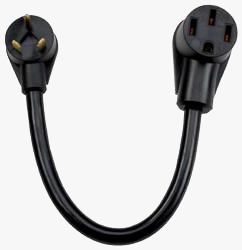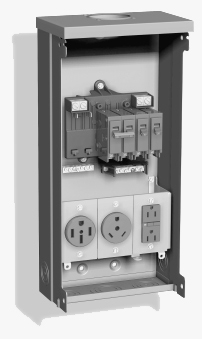Library Contents Search the Library RV Tech Library Help Page Site Map About Us Tiffin RV Network TRVN Classifieds Campground Reviews Photo Gallery TRVN Store
Appliances Batteries Boondocking/Dry Camping Chassis Clubs & Forums Electrical Electronics Engines Exterior Maintenance Generators Heating & Air Conditioning Interior Maintenance Misc Items Operating Tips Plumbing Red Bay Safety & Health Storage Supplier Contacts Tires and Wheel Rims Towing Transmissions Weighing

Shore Power Connections
Shore power can be provided to an RV via 3 common services 20 amp, 30 amp, and 50 amp. The shore power feeds the automatic transfer switch which then feeds the AC breaker panel. This is different from a residential electrical system. Residential systems are fed a large capacity service. This service is split between the two poles of the breaker panel, called the X phase and Y phase. A third wire is also run to a lug strip and this is the neutral wire. If you connect across the X phase and Y phase you will have 240 volts. If you connect from either the X or Y phase to the neutral wire you will have 120 volts.
If you plug an RV into a 50 amp service you will have pretty much the same thing. Each phase is capable of 50 amps therefore you have a total power capacity of 12,000 watts from these two poles (50 amps x 2 poles x 120 volts = 6,000 watts). A 50 amp shore power receptacle contains 4 wires - the X phase, Y phase, neutral, and a ground lug. The X phase feeds one side of your breaker panel while the Y phase feeds the other half.
When you plug into a 30 amp shore power receptacle there are only 3 wires - the hot phase, the neutral phase, and a ground. The hot phase could be either X or Y, depending upon how the pedestal was wired, but it really doesn't matter because you are only getting a single phase. So, a 30 amp shore power receptacle will give you 3,600 watts (30 amps x 1 pole x 120 volts = 3,600 watts).
But, in order to supply a 50 amp coach with power on both sides of the breaker panel some mods have to be made. Any RVer with a 50 amp service should have a 30 amp to 50 amp cord adaptor, commonly called a dog bone, handy for those times when a 50 amp service is not available. This dog bone adaptor takes the 30 amp hot phase and wyes it to both of the 50 amp hot phases. That way you are supplying both halves of the breaker panel with power. You still only get 30 amps or 3,600 watts of power but at least it is available to any circuit in your coach. If you are plugging into a 20 amp circuit you buy a 15 amp to 30 amp adaptor that attaches to the end of the dog bone. This seriously limits what you can run but is useful to keep your batteries charged.
|
Here's a cutaway view of a typical RV pedestal. The 3 breakers across the top row are, from left to right, a 50 amp 2 pole, a 30 amp single pole, and a 20 amp single pole. The outlets across the bottom are in the same order - a 50 amp 120/240 volt 4 wire, a 30 amp 120 volt 3 wire, and a 15 amp 120 volt 3 wire GFCI receptacle. Also shown below is a 30 to 50 dog bone adaptor to plug a 50 amp RV into a 30 amp receptacle.
|
|
While the 15 amp duplex receptacle is a standard configuration, the 30 amp receptacle is an RV-only receptacle. The NEMA code number for this receptacle is TT30R and the plug is a TT-30P (The TT stands for Travel Trailer). The 50 amp receptacle is the new 4 wire range style receptacle, NEMA # 1450R. The round blade receptors are for the ground wires on all 3 of the above receptacles. On both the 20 and 30 amp receptacles the shorter flat blade receptors are for the hot leads while the longer flat blade slots are for the neutral leads. On the 50 amp 4 wire receptacle the two side slots are both hot and the center flat blade slot is the neutral. It's not important which hot phase goes to which hot slot terminal on the 50 amp receptacle.
Submitted by Mark Quasius - 2/24/06
Click Your browser's "Back" button to return to the previous page
or chose another category from the side menu.
The RV Tech Library is brought to you by the TiffinRVnetwork
Absolutely No Affiliation exists between this group and Tiffin Motor Homes Inc or the Allegro Club. This website neither endorses or discourages the use or purchase of a Tiffin product. All references, suggestions, comments, etc. contained herein are the opinions/experiences of the posters and not those of Tiffin Motor Homes Inc. or the website administrators.





